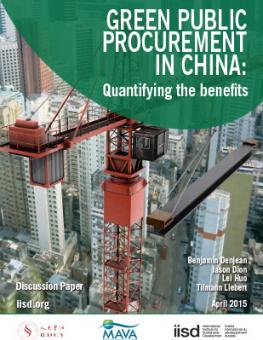
Green Public Procurement in China: Quantifying the benefits (Discussion Paper)
Since the official introduction of green public procurement (GPP) in China in 2006, the country has made much progress in increasing the environmental and energy-efficiency performance of purchased products.
Nonetheless, as this discussion paper argues, there is large potential for further increasing both the volume and the stringency of green requirements to scale up GPP, thereby contributing to the development of eco-civilization and other Chinese priorities. The first-of-its-kind model developed by IISD and presented in this paper shows there are significant environmental, social and economic benefits that China could achieve by leveraging the huge sums involved in public spending. The model points to reduced air pollution and greenhouse gas emissions, reduced health costs, green jobs, energy savings, green economic development and competitiveness. The major areas of Chinese public spending covered by the model are air conditioners, vehicles, information technology equipment, lighting, cement and paper. The paper further provides an overview of the country’s public procurement systems; outlines the current approach to GPP implementation, including its legal framework; undertakes a preliminary evaluation of the effectiveness of current GPP practice; and discusses the current policy and institutional reforms that benefit GPP. The paper concludes with a set of preliminary recommendations to scale up GPP. This product was launched at a joint IISD–Chongyang Institute for Financial Studies event on April 20, 2015, where Chinese and international experts discussed its findings and how to advance GPP in China.
Additional downloads
You might also be interested in
How Green Public Procurement Contributes to Sustainable Development in China
Building on the results of the IISD Green Public Procurement (GPP) Model, consultations with stakeholders and an extensive literature review, this paper provides targeted recommendations addressing the development areas identified to improve GPP in China.
Financing Models for Soil Remediation in China
This report examines seven different types of soil remediation projects in China and provides a "state-of-play" survey of financing models for soil rehabilitation in China.
Monitoring Progress in Green Public Procurement
This report outlines the importance of monitoring progress in green public procurement (GPP) and highlights various methodologies, challenges, and recommendations.
Gender Equality at the Heart of Recovery: Advocating for Gender-Responsive Procurement in Ukraine
Ukraine is already preparing for reconstruction, which will cost an estimated USD 411 billion and take at least 10 years. The integration of gender considerations into public procurement processes could generate greater inclusivity in a rebuilt Ukraine.